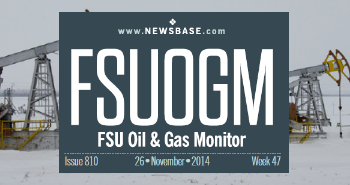INTERVIEW: Block Energy’s quest for gas in Georgia

“Project III has the potential to be of major importance to the Georgian energy market as well as acting as a catalyst for further investments into the hydrocarbon sector in the country,” said Block Energy’s commercial manager, Fergus Robson.
WHAT: London-listed Block Energy is seeking partners for what could prove a transformational natural gas project in Georgia.
WHY: Project III’s 2C recoverable contingent gas resources are assessed at 84 bcm, with data so far indicating it could potentially flow more gas than import-dependent Georgia currently consumes.
WHAT NEXT: Block needs partners to move ahead with appraisal and development.
London-listed Block Energy is continuing its search for partners to appraise and develop a multi-trillion cubic foot gas resource in Georgia that, should it live up to early assessments, prove transformational for the country’s energy sector, the company’s commercial manager, Fergus Robson, told NewsBase.
Georgia produces only very modest amounts of oil and gas – a mere 780 barrels per day (bpd) and 16.4mn cubic metres of natural gas in 2023, leaving the country almost entirely reliant on imports. Oil production is a far cry from the heyday of the 1980s, when the giant Patardzueli-Samgori field was in its prime and producing up to 70,000 bpd.
Block entered Georgia in 2017, and today has interests in seven production-sharing contracts (PSCs). Today it is the country’s biggest oil and gas producer, lifting 455 barrels of oil equivalent per day (boepd) in the first half of last year, of which around three-quarters was oil and the rest gas, from Patardzueli-Samgori and another, smaller Soviet-era field, West Rustavi/Krtsanisi. But its flagship asset is Project III, comprising three discovered gas fields, with two proven reservoirs in Lower Eocene and Upper Cretaceous layers found underneath its existing oil operations.
“Project III has the potential to be of major importance to the Georgian energy market as well as acting as a catalyst for further investments into the hydrocarbon sector in the country,” Robson said.

Block Energy commercial manager Fergus Robson
Work so far
Patardzueli-Samgori is also the initial appraisal target for Project III, with the focus on the site’s gas formations located underneath its producing oil reservoirs. Traditionally, upstream development in Georgia has focused on oil, while gas has largely been overlooked, Robson said. These reservoirs are also very complicated, with natural fracturing caused by tectonic activity resulting from the collision of the Eurasian and Arabian plates many millions of years ago. Modern technologies have been able to unlock similar types of fields, with projects in Kurdistan being an example.
US oilfield services giant Schlumberger drilled a well at Patardzueli-Samgori to appraise the deeper gas in 2018, with Block acquiring the licence two years later. More than 15 gas tests have been undertaken at the three gas fields, with the company having an “excellent” dataset also including 3D seismic, logs and other geological and geophysical information, Robson said.
An independent audit by UK geoscience consultancy OPC published in February last year places Patardzueli-Samgori’s 2C recoverable contingent gas resources at 1.2 trillion cubic feet (35bn cubic metres), with 2C resources across Project III’s fields assessed at 2.9 tcf (84 bcm). Block completed an integrated full field development study in 2023, including reinterpretation of 3D seismic data, well design and planning, third-party conceptual development engineering and cost estimates of a pilot scheme and full field processing facilities.
What next?
While work so far has been funded through Block’s cash flow from existing oil and gas sales, the company launched a farm-out process in February last year to accelerate further appraisal, including drilling, and subsequent development across Project III. Since then, the company has reported interest from multiple parties, but no preliminary agreements have been announced.
Based on data so far, Block estimates that a plateau production rate of 500mn cubic feet per day, or 4.7 bcm per year, could be achieved from Project III, including 200 mmcf (5.66 mcm) per day from Patardzueli-Samgori, with first gas sales starting 12 months after the start of appraisal. Put in context, that is around 40% more gas than Georgia consumes.
“We’re at the position now where we’ve basically done everything you can do without more reservoir drilling. We know there’s proven gas there, we’ve done multiple gas tests with decent flow rates,” Robson said. “That’s why we are now very keen to advance the appraisal project.”
Based on assessed 2C resources, Block estimates that Project III’s development would cost $2bn in total capital expenditure, while generating over $7bn in cash flow. But as the project can be monetised quickly owing to the existing infrastructure and the benign operating environment, the total capital exposure is low, at only $183mn, according to Robson. Costs are assessed at only just over $8 per boe, with a netback of $22.5 per boe. Its internal rate of return is estimated at 71.7%.
The project’s prospects are buoyed even further by what Robson described as “an excellent jurisdiction to work in with a world-class operating environment and a good business environment in general” in Georgia. He also noted the country’s strong investment protection, streamlined bureaucracy and simple PSC fiscal system, consisting only of cost gas and profit gas without royalties, taxes, fees, bonuses or profit limits.
Beyond serving the domestic market, Project III would also have full rights to export its gas, taking advantage of its close proximity of only 15 km to the South Caucasus gas pipeline that forms part of the Southern Gas Corridor (SGC) linking Azerbaijan with Turkey and southeast Europe.
If you’d like to read more about the key events shaping the former Soviet Union’s oil and gas sector then please click here for NewsBase’s FSU Oil and Gas Monitor.


Follow us online